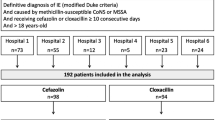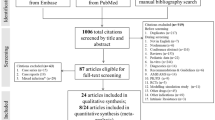Summary
The new oral cephalosporins cefpodoxime, cefixime, cefdinir, cefetamet and ceftibuten demonstrate enhanced activity against Enterobacteriaceae susceptible to the established compounds as well (e.g. cefuroxime, cefaclor, cefadroxil). In addition, cefpodoxime, cefixime, cefdinir, cefetamet and ceftibuten include in their spectrum species hitherto resistant to oral cephalosporins (Proteus vulgaris, Providencia spp.,Yersinia enterocolitica). Besides, the majority of these compounds demonstrate relevant activity (MIC50 equal to or below 2 mg/l) againstEnterobacter spp.,Citrobacter freundii, Serratia spp. andMorganella morganii. Ceftibuten is the most potent oral cephalosporin against most of the Enterobacteriaceae. Non-fermentative bacilli (Acinetobacter spp.,Pseudomonas spp.) remain completely resistant to oral cephalosporins (except someAcinetobacter species against cefdinir andPseudomonas cepacia against ceftibuten). Antistaphylococcal activity for oral cephalosporins is highest for cefdinir followed by BAY 3522, cefprozil, cefuroxime and cefpodoxime. Loracarbef, cefaclor and cefadroxil are about equally active, while the other compounds are only weakly active (cefixime) or inactive (cefetamet, ceftibuten). Enterococci are insensitive to new generation oral cephalosporins as they have been to established compounds. The most active oral cephalosporins against hemolytic streptococci are cefdinir and cefprozil.Streptococcus pneumoniae, Streptococcus milleri andStreptococcus mitior are most susceptible to cefpodoxime, cefdinir, cefuroxime and BAY 3522. Penicillin resistant pneumococci have to be regarded as resistant to all oral cephalosporins. Fastidious pathogens likeHaemophilus spp.,Moraxella catarrhalis andNeisseria gonorrhoeae are more susceptible to cefpodoxime, cefixime, cefdinir, cefetamet and ceftibuten than to the other oral cephalosporins. The activity of oral cephalosporins is only weak againstListeria spp.,Helicobacter pylori and anaerobic pathogens (except BAY 3522).Bordetella pertussis remains resistant to all absorbable cephalosporins. Progress in antibacterial activity of oral cephalosporins was mainly achieved by cefpodoxime, cefixime, cefdinir, cefetamet and ceftibuten against Enterobacteriaceae and the fastidious pathogens and against staphylococci and the nonenterococcal streptococci by cefdinir, BAY 3522, cefprozil and cefpodoxime.
Zusammenfassung
Die neuen oralen Cephalosporine Cefpodoxim, Cefixim, Cefdinir, Cefetamet und Ceftibuten zeigen eine verstärkte Aktivität auch gegen solche Enterobacteriaceae, die gegen etablierte Substanzen empfindlich sind (z.B. Cefuroxim, Cefaclor, Cefadroxil). Zusätzlich schließt das Spektrum von Cefpodoxim, Cefixim, Cefdinir, Cefetamet und Ceftibuten Spezies ein, die gegen die bisherigen oralen Cephalosporine resistent waren (Proteus vulgaris, Providencia spp.,Yersinia enterocolitica). Daneben zeigt die Mehrheit der neuen Substanzen erhöhte Aktivität (MHK50<2 mg/l) gegenEnterobacter spp.,Citrobacter freundii, Serratia spp. undMorganella morganii. Gegen die meisten Enterobacteriaceae ist Ceftibuten das wirksamste orale Cephalosporin. Non-Fermenter (Acinetobacter spp.,Pseudomonas spp.) bleiben gegenüber oralen Cephalosporinen vollständig resistent (mit Ausnahme einigerAcinetobacter-Spezies gegen Cefdinir undPseudomonas cepacia gegen Ceftibuten). Die Antistaphylokokken-Aktivität oraler Cephalosporine ist am höchsten bei Cefdinir, gefolgt von BAY 3522, Cefprozil, Cefuroxim und Cefpodoxim. Loracarbef, Cefaclor und Cefadroxil sind etwa gleich aktiv, während die anderen Substanzen nur schwach aktiv (Cefixim) oder inaktiv sind (Cefetamet, Ceftibuten). Enterokokken sind gegenüber der neuen Generation oraler Cephalosporine ebenso unempfindlich wie gegenüber den etablierten Substanzen. Die aktivsten oralen Cephalosporine gegen hämolysierende Streptokokken sind Cefdinir und Cefprozil.Streptococcus pneumoniae, Streptococcus milleri undStreptococcus mitior sind am empfindlichsten gegen Cefpodoxim, Cefdinir, Cefuroxim und BAY 3522. Penicillin-resistente Pneumokokken müssen als resistent gegenüber allen oralen Cephalosporinen betrachtet werden. Anspruchsvolle Erreger wieHaemophilus spp.,Moraxella catarrhalis undNeisseria gonorrhoeae sind gegen Cefpodoxim, Cefixim, Cefdinir, Cefetamet und Ceftibuten empfindlicher als gegen die anderen oralen Cephalosporine. Die Aktivität oraler Cephalosporine gegenListeria spp.,Helicobacter pylori und Anaerobier (Ausnahme BAY 3522) ist nur schwach.Bordetella pertussis bleibt gegen alle resorbierbaren Cephalosporine resistent. Der Fortschritt in der antibakteriellen Aktivität oraler Cephalosporine wurde gegen Enterobacteriaceae und anspruchsvolle Erreger hauptsächlich durch Cefpodoxim, Cefixim, Cefdinir, Cefetamet und Ceftibuten erlangt, gegen Staphylokokken und Streptokokken (außer Enterokokken) durch Cefdinir, BAY 3522, Cefprozil und Cefpodoxim.
Similar content being viewed by others
References
Neu, H. C., Fu, K. P. Cefaclor:In vitro spectrum of activity and beta-lactamase stability. Antimicrob. Agents Chemother. 13 (1978) 584–588.
Grimm, H. Bakteriologischein vitro Untersuchungen mit Cefaclor. Infection 7 Suppl. 6 (1979) 540–542.
Mittermayer, H. In vitro activity of cefetamet (Ro 15-8074) Eur. J. Clin. Microbiol. 5 (1986) 530–534.
Mabilat, C., Courvalin, P. Development of “oligotyping” for characterization and molecular epidemiology of TEM β-lactamases in members of the family Enterobacteriaceae. Antimicrob. Agents Chemother. 34 (1990) 2210–2216.
Hoppe, J. E., Müller, J. In vitro susceptibilities ofBordetella pertussis andBordetella parapertussis to six new oral cephalosporins. Antimicrob. Agents Chemother. 34 (1990) 1442–1443.
Bauernfeind, A.: In vitro activity and stability against novel beta-lactamases of flomoxef in comparison with latamoxef, SCE 2787, cefpirome, cefepime, cefotaxime, piperacillin and piperacillin plus tazobactam. Infection (in press).
Bauernfeind, A. Comparative antimicrobial spectrum and activity of ceftibuten against clinical isolates from West Germany. Diagnost. Microbiol. Infect. Dis. 4 (1991) 63–74.
Bauernfeind, A., Przyklenk, B., Matthias, C., Jungwirth, R., Bertele, R. M., Harms, K. Selection of antibiotics for treatment and prophylaxis of staphylococcal infections in cystic fibrosis patients. Infection 18 (1990) 126–130.
Author information
Authors and Affiliations
Additional information
Supported by Luitpold-Werk, a company of the Sankyo group.
Rights and permissions
About this article
Cite this article
Bauernfeind, A., Jungwirth, R. Antibacterial activity of cefpodoxime in comparison with cefixime, cefdinir, cefetamet, ceftibuten, loracarbef, cefprozil, BAY 3522, cefuroxime, cefaclor and cefadroxil. Infection 19, 353–362 (1991). https://doi.org/10.1007/BF01645369
Issue Date:
DOI: https://doi.org/10.1007/BF01645369




